Impact of Change on Organisational Strategies and Operations Report
VerifiedAdded on 2020/09/08
|16
|4368
|124
Report
AI Summary
This report delves into the multifaceted aspects of understanding and leading change within organizations, particularly focusing on the retail giants M&S and Tesco. It begins by outlining the impact of change on organizational strategies and operations, differentiating between internal and external drivers such as employee morale, technological advancements, and economic fluctuations. The report further explores how these drivers influence leadership, team dynamics, and individual behavior, highlighting the significance of change impact analysis theories to mitigate negative consequences. It examines barriers to change and their effect on leadership decision-making, including the application of force field analysis to identify driving and resisting forces. Finally, the report assesses different leadership approaches to manage change effectively, evaluating their capacity to deliver organizational transformation through various models and frameworks. The analysis underscores the importance of proactive change management in maintaining competitiveness and achieving organizational goals in a dynamic business environment.
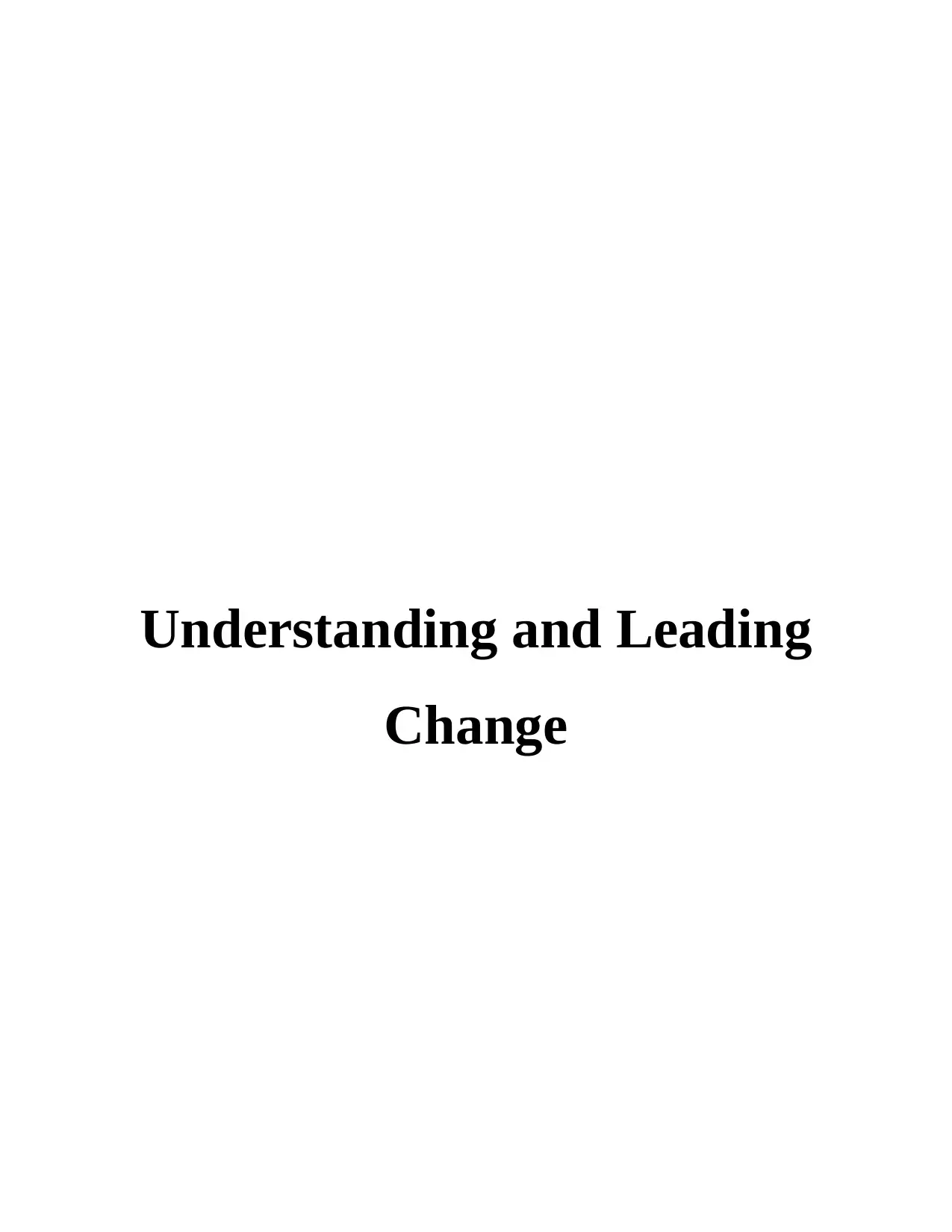
Understanding and Leading
Change
Change
Paraphrase This Document
Need a fresh take? Get an instant paraphrase of this document with our AI Paraphraser

Table of Contents
INTRODUCTION...........................................................................................................................1
TASK 1............................................................................................................................................1
P1 Impact of change on organisational strategies and operations..........................................1
P2 Impact of internal and external drivers of change on leadership, team and individual
behaviour................................................................................................................................4
P3 Measures that can be taken to minimise negative impacts of change ..............................6
M1: Assess the different drivers for change and the types of organisational change they have
affected...................................................................................................................................7
M2: Apply appropriate theories and models to critically evaluate organisational response to
change.....................................................................................................................................7
P4 Different barriers for change and their influence on leadership decision-making ...........8
M3: Using force field analysis to analysis the driving and resisting forces and how they
influence decision making......................................................................................................9
P5 Different leadership approaches to deal with changes....................................................10
M4: Evaluate the extent to which leadership approaches can deliver organisational change by
applying appropriate models and frameworks.....................................................................10
CONCLUSION..............................................................................................................................11
REFERENCES..............................................................................................................................12
.......................................................................................................................................................13
INTRODUCTION...........................................................................................................................1
TASK 1............................................................................................................................................1
P1 Impact of change on organisational strategies and operations..........................................1
P2 Impact of internal and external drivers of change on leadership, team and individual
behaviour................................................................................................................................4
P3 Measures that can be taken to minimise negative impacts of change ..............................6
M1: Assess the different drivers for change and the types of organisational change they have
affected...................................................................................................................................7
M2: Apply appropriate theories and models to critically evaluate organisational response to
change.....................................................................................................................................7
P4 Different barriers for change and their influence on leadership decision-making ...........8
M3: Using force field analysis to analysis the driving and resisting forces and how they
influence decision making......................................................................................................9
P5 Different leadership approaches to deal with changes....................................................10
M4: Evaluate the extent to which leadership approaches can deliver organisational change by
applying appropriate models and frameworks.....................................................................10
CONCLUSION..............................................................................................................................11
REFERENCES..............................................................................................................................12
.......................................................................................................................................................13

⊘ This is a preview!⊘
Do you want full access?
Subscribe today to unlock all pages.

Trusted by 1+ million students worldwide
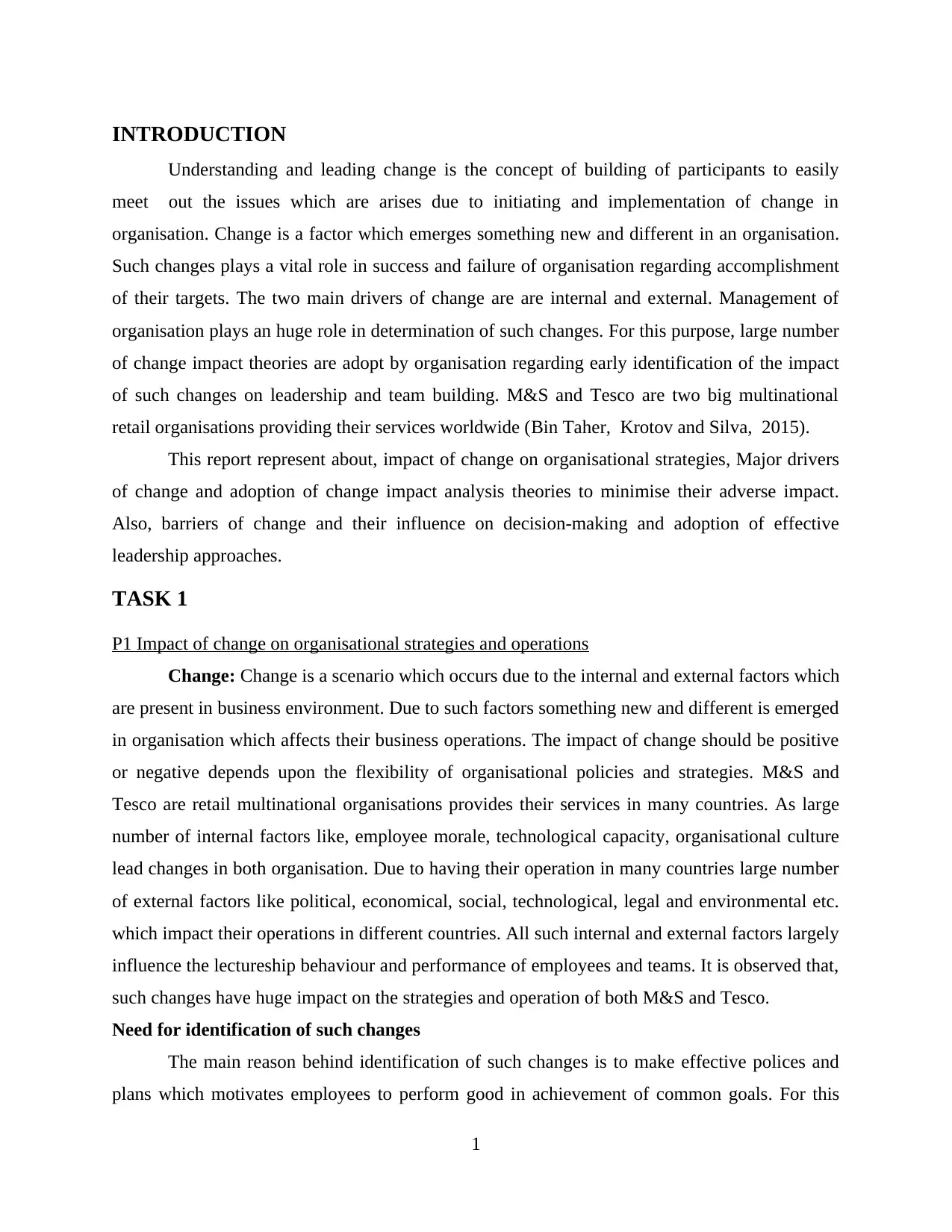
INTRODUCTION
Understanding and leading change is the concept of building of participants to easily
meet out the issues which are arises due to initiating and implementation of change in
organisation. Change is a factor which emerges something new and different in an organisation.
Such changes plays a vital role in success and failure of organisation regarding accomplishment
of their targets. The two main drivers of change are are internal and external. Management of
organisation plays an huge role in determination of such changes. For this purpose, large number
of change impact theories are adopt by organisation regarding early identification of the impact
of such changes on leadership and team building. M&S and Tesco are two big multinational
retail organisations providing their services worldwide (Bin Taher, Krotov and Silva, 2015).
This report represent about, impact of change on organisational strategies, Major drivers
of change and adoption of change impact analysis theories to minimise their adverse impact.
Also, barriers of change and their influence on decision-making and adoption of effective
leadership approaches.
TASK 1
P1 Impact of change on organisational strategies and operations
Change: Change is a scenario which occurs due to the internal and external factors which
are present in business environment. Due to such factors something new and different is emerged
in organisation which affects their business operations. The impact of change should be positive
or negative depends upon the flexibility of organisational policies and strategies. M&S and
Tesco are retail multinational organisations provides their services in many countries. As large
number of internal factors like, employee morale, technological capacity, organisational culture
lead changes in both organisation. Due to having their operation in many countries large number
of external factors like political, economical, social, technological, legal and environmental etc.
which impact their operations in different countries. All such internal and external factors largely
influence the lectureship behaviour and performance of employees and teams. It is observed that,
such changes have huge impact on the strategies and operation of both M&S and Tesco.
Need for identification of such changes
The main reason behind identification of such changes is to make effective polices and
plans which motivates employees to perform good in achievement of common goals. For this
1
Understanding and leading change is the concept of building of participants to easily
meet out the issues which are arises due to initiating and implementation of change in
organisation. Change is a factor which emerges something new and different in an organisation.
Such changes plays a vital role in success and failure of organisation regarding accomplishment
of their targets. The two main drivers of change are are internal and external. Management of
organisation plays an huge role in determination of such changes. For this purpose, large number
of change impact theories are adopt by organisation regarding early identification of the impact
of such changes on leadership and team building. M&S and Tesco are two big multinational
retail organisations providing their services worldwide (Bin Taher, Krotov and Silva, 2015).
This report represent about, impact of change on organisational strategies, Major drivers
of change and adoption of change impact analysis theories to minimise their adverse impact.
Also, barriers of change and their influence on decision-making and adoption of effective
leadership approaches.
TASK 1
P1 Impact of change on organisational strategies and operations
Change: Change is a scenario which occurs due to the internal and external factors which
are present in business environment. Due to such factors something new and different is emerged
in organisation which affects their business operations. The impact of change should be positive
or negative depends upon the flexibility of organisational policies and strategies. M&S and
Tesco are retail multinational organisations provides their services in many countries. As large
number of internal factors like, employee morale, technological capacity, organisational culture
lead changes in both organisation. Due to having their operation in many countries large number
of external factors like political, economical, social, technological, legal and environmental etc.
which impact their operations in different countries. All such internal and external factors largely
influence the lectureship behaviour and performance of employees and teams. It is observed that,
such changes have huge impact on the strategies and operation of both M&S and Tesco.
Need for identification of such changes
The main reason behind identification of such changes is to make effective polices and
plans which motivates employees to perform good in achievement of common goals. For this
1
Paraphrase This Document
Need a fresh take? Get an instant paraphrase of this document with our AI Paraphraser

purpose, effective change management impact analysis theories are adopted by both M&S and
Tesco. It helps in early identification and minimise their adverse impact on their future
operations. As large opportunities are gather by organisations due to identification of such
changes are define below:
Encourage innovation: Identification and implementation of changes motivates the
employees to improve their skills and knowledge regarding effectively accept such
factors in their normal routine work. Such changes helps to encourage employees to
increase their passion towards their functions (Brazer and Bauer, 2011).
Ascertain position in market: If the multinational organisations like M&S and Tesco,
not give emphasis on internal and external drivers of change them it will reduce their
competitiveness in market. It provides opportunity to other organisation to capture their
market. So, to make their position and attain competitive advantage necessary to adopt
changes.
Team building: Completion of organisational objectives depends upon the working of
employees as team. Non consideration of changes effects communication and leadership
among team members. So, to build effective teams necessary to ascertain the impact of
such changes.
Marks and Spencer: It is British multinational organisation which is headquartered in
London. It is also listed in London stock exchange. It provides their products and services in
worldwide. The major products in which M&S deals includes clothing, home products, luxury
food products etc. In UK, M&S has more than 979 stores and also having 454 international
stores. 84939 employees are presently working to effectively manage the functions of M&S. The
profit generated by organisation through their services is £ 115.7 million.
Tesco: It is also multinational retail organisation headquartered in UK. Tesco considered
as third largest retailer in terms of profit and one of the leading company in UK. It has their
stores in more than 12 countries. This company deals in grocery and general merchandise
products. The revenue earned by company in 2017 is £ 55917 million.
Impact of change on organisational strategy and operations
It is mentioned above that both organisation deals in diversifies products in overall
country. So, there is huge importance of internal factors in success of organisation. Similarly,
different countries have various business environments. In today's world, the major change
2
Tesco. It helps in early identification and minimise their adverse impact on their future
operations. As large opportunities are gather by organisations due to identification of such
changes are define below:
Encourage innovation: Identification and implementation of changes motivates the
employees to improve their skills and knowledge regarding effectively accept such
factors in their normal routine work. Such changes helps to encourage employees to
increase their passion towards their functions (Brazer and Bauer, 2011).
Ascertain position in market: If the multinational organisations like M&S and Tesco,
not give emphasis on internal and external drivers of change them it will reduce their
competitiveness in market. It provides opportunity to other organisation to capture their
market. So, to make their position and attain competitive advantage necessary to adopt
changes.
Team building: Completion of organisational objectives depends upon the working of
employees as team. Non consideration of changes effects communication and leadership
among team members. So, to build effective teams necessary to ascertain the impact of
such changes.
Marks and Spencer: It is British multinational organisation which is headquartered in
London. It is also listed in London stock exchange. It provides their products and services in
worldwide. The major products in which M&S deals includes clothing, home products, luxury
food products etc. In UK, M&S has more than 979 stores and also having 454 international
stores. 84939 employees are presently working to effectively manage the functions of M&S. The
profit generated by organisation through their services is £ 115.7 million.
Tesco: It is also multinational retail organisation headquartered in UK. Tesco considered
as third largest retailer in terms of profit and one of the leading company in UK. It has their
stores in more than 12 countries. This company deals in grocery and general merchandise
products. The revenue earned by company in 2017 is £ 55917 million.
Impact of change on organisational strategy and operations
It is mentioned above that both organisation deals in diversifies products in overall
country. So, there is huge importance of internal factors in success of organisation. Similarly,
different countries have various business environments. In today's world, the major change
2
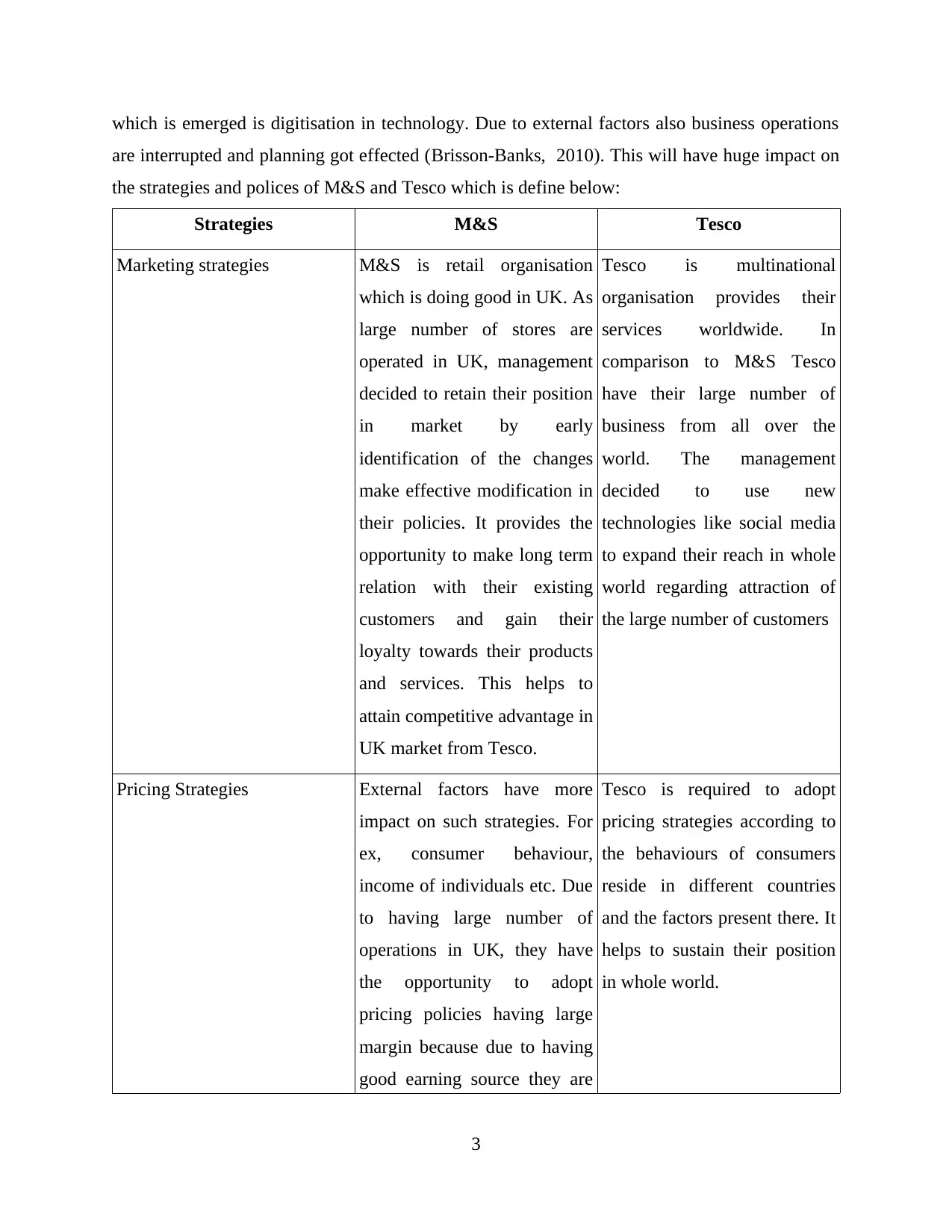
which is emerged is digitisation in technology. Due to external factors also business operations
are interrupted and planning got effected (Brisson-Banks, 2010). This will have huge impact on
the strategies and polices of M&S and Tesco which is define below:
Strategies M&S Tesco
Marketing strategies M&S is retail organisation
which is doing good in UK. As
large number of stores are
operated in UK, management
decided to retain their position
in market by early
identification of the changes
make effective modification in
their policies. It provides the
opportunity to make long term
relation with their existing
customers and gain their
loyalty towards their products
and services. This helps to
attain competitive advantage in
UK market from Tesco.
Tesco is multinational
organisation provides their
services worldwide. In
comparison to M&S Tesco
have their large number of
business from all over the
world. The management
decided to use new
technologies like social media
to expand their reach in whole
world regarding attraction of
the large number of customers
Pricing Strategies External factors have more
impact on such strategies. For
ex, consumer behaviour,
income of individuals etc. Due
to having large number of
operations in UK, they have
the opportunity to adopt
pricing policies having large
margin because due to having
good earning source they are
Tesco is required to adopt
pricing strategies according to
the behaviours of consumers
reside in different countries
and the factors present there. It
helps to sustain their position
in whole world.
3
are interrupted and planning got effected (Brisson-Banks, 2010). This will have huge impact on
the strategies and polices of M&S and Tesco which is define below:
Strategies M&S Tesco
Marketing strategies M&S is retail organisation
which is doing good in UK. As
large number of stores are
operated in UK, management
decided to retain their position
in market by early
identification of the changes
make effective modification in
their policies. It provides the
opportunity to make long term
relation with their existing
customers and gain their
loyalty towards their products
and services. This helps to
attain competitive advantage in
UK market from Tesco.
Tesco is multinational
organisation provides their
services worldwide. In
comparison to M&S Tesco
have their large number of
business from all over the
world. The management
decided to use new
technologies like social media
to expand their reach in whole
world regarding attraction of
the large number of customers
Pricing Strategies External factors have more
impact on such strategies. For
ex, consumer behaviour,
income of individuals etc. Due
to having large number of
operations in UK, they have
the opportunity to adopt
pricing policies having large
margin because due to having
good earning source they are
Tesco is required to adopt
pricing strategies according to
the behaviours of consumers
reside in different countries
and the factors present there. It
helps to sustain their position
in whole world.
3
⊘ This is a preview!⊘
Do you want full access?
Subscribe today to unlock all pages.

Trusted by 1+ million students worldwide
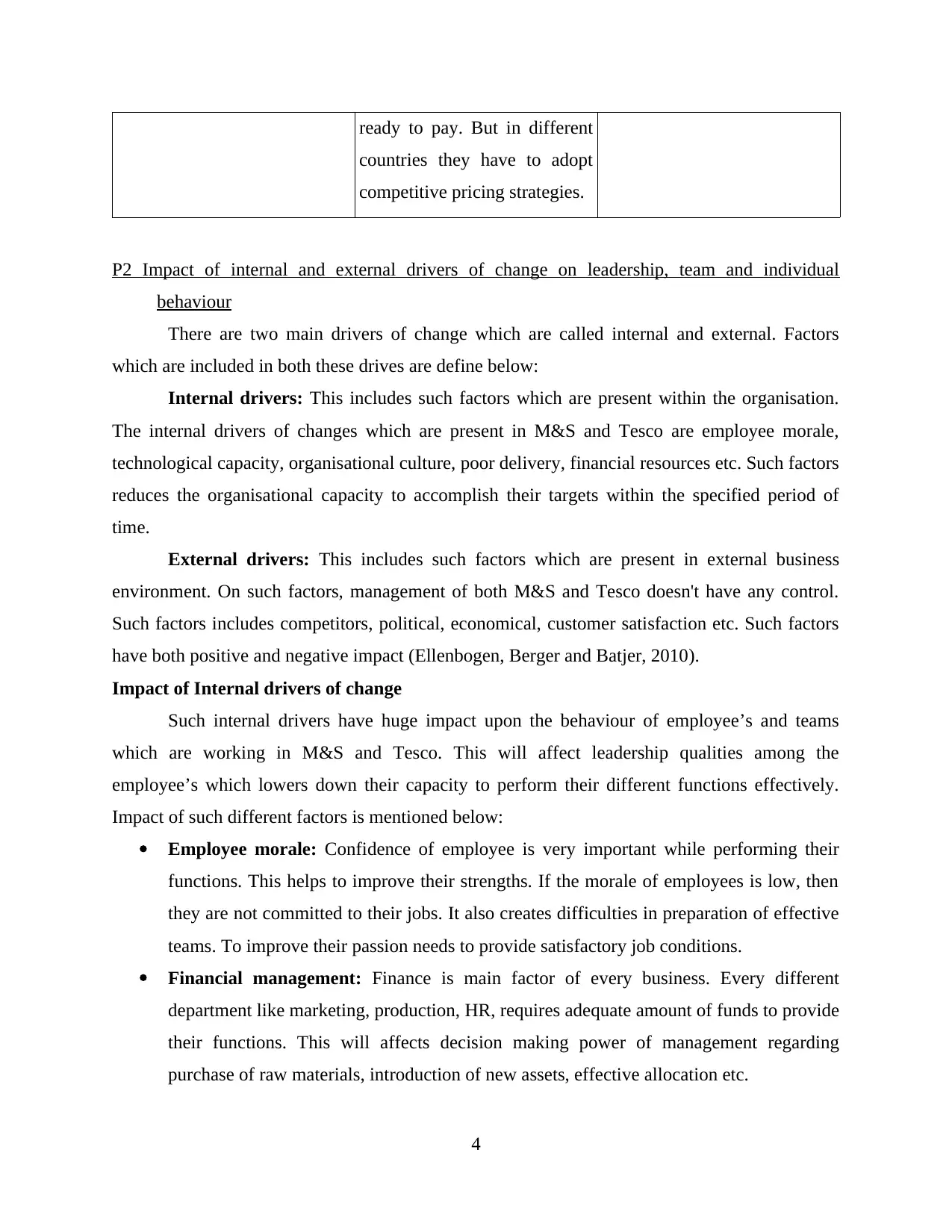
ready to pay. But in different
countries they have to adopt
competitive pricing strategies.
P2 Impact of internal and external drivers of change on leadership, team and individual
behaviour
There are two main drivers of change which are called internal and external. Factors
which are included in both these drives are define below:
Internal drivers: This includes such factors which are present within the organisation.
The internal drivers of changes which are present in M&S and Tesco are employee morale,
technological capacity, organisational culture, poor delivery, financial resources etc. Such factors
reduces the organisational capacity to accomplish their targets within the specified period of
time.
External drivers: This includes such factors which are present in external business
environment. On such factors, management of both M&S and Tesco doesn't have any control.
Such factors includes competitors, political, economical, customer satisfaction etc. Such factors
have both positive and negative impact (Ellenbogen, Berger and Batjer, 2010).
Impact of Internal drivers of change
Such internal drivers have huge impact upon the behaviour of employee’s and teams
which are working in M&S and Tesco. This will affect leadership qualities among the
employee’s which lowers down their capacity to perform their different functions effectively.
Impact of such different factors is mentioned below:
Employee morale: Confidence of employee is very important while performing their
functions. This helps to improve their strengths. If the morale of employees is low, then
they are not committed to their jobs. It also creates difficulties in preparation of effective
teams. To improve their passion needs to provide satisfactory job conditions.
Financial management: Finance is main factor of every business. Every different
department like marketing, production, HR, requires adequate amount of funds to provide
their functions. This will affects decision making power of management regarding
purchase of raw materials, introduction of new assets, effective allocation etc.
4
countries they have to adopt
competitive pricing strategies.
P2 Impact of internal and external drivers of change on leadership, team and individual
behaviour
There are two main drivers of change which are called internal and external. Factors
which are included in both these drives are define below:
Internal drivers: This includes such factors which are present within the organisation.
The internal drivers of changes which are present in M&S and Tesco are employee morale,
technological capacity, organisational culture, poor delivery, financial resources etc. Such factors
reduces the organisational capacity to accomplish their targets within the specified period of
time.
External drivers: This includes such factors which are present in external business
environment. On such factors, management of both M&S and Tesco doesn't have any control.
Such factors includes competitors, political, economical, customer satisfaction etc. Such factors
have both positive and negative impact (Ellenbogen, Berger and Batjer, 2010).
Impact of Internal drivers of change
Such internal drivers have huge impact upon the behaviour of employee’s and teams
which are working in M&S and Tesco. This will affect leadership qualities among the
employee’s which lowers down their capacity to perform their different functions effectively.
Impact of such different factors is mentioned below:
Employee morale: Confidence of employee is very important while performing their
functions. This helps to improve their strengths. If the morale of employees is low, then
they are not committed to their jobs. It also creates difficulties in preparation of effective
teams. To improve their passion needs to provide satisfactory job conditions.
Financial management: Finance is main factor of every business. Every different
department like marketing, production, HR, requires adequate amount of funds to provide
their functions. This will affects decision making power of management regarding
purchase of raw materials, introduction of new assets, effective allocation etc.
4
Paraphrase This Document
Need a fresh take? Get an instant paraphrase of this document with our AI Paraphraser
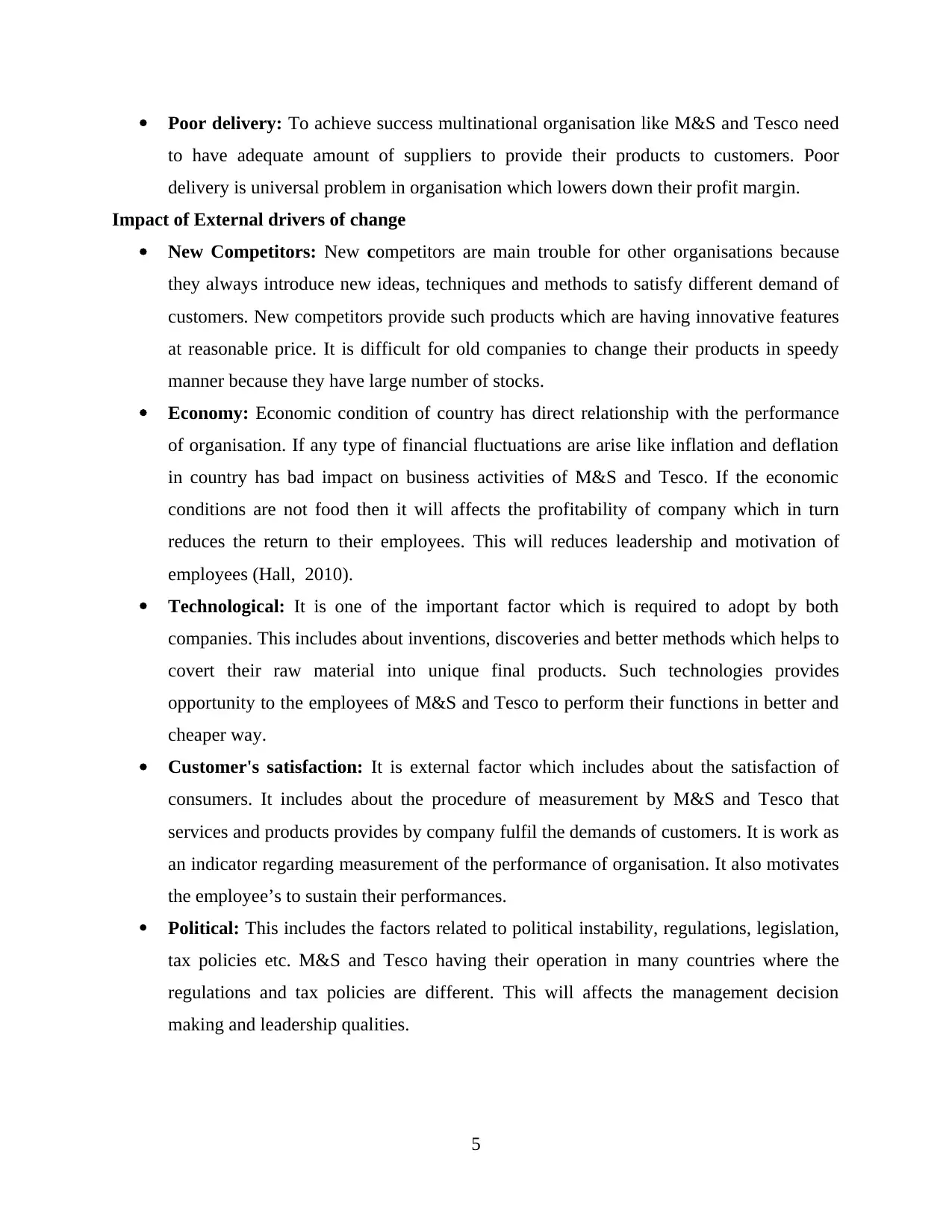
Poor delivery: To achieve success multinational organisation like M&S and Tesco need
to have adequate amount of suppliers to provide their products to customers. Poor
delivery is universal problem in organisation which lowers down their profit margin.
Impact of External drivers of change
New Competitors: New competitors are main trouble for other organisations because
they always introduce new ideas, techniques and methods to satisfy different demand of
customers. New competitors provide such products which are having innovative features
at reasonable price. It is difficult for old companies to change their products in speedy
manner because they have large number of stocks.
Economy: Economic condition of country has direct relationship with the performance
of organisation. If any type of financial fluctuations are arise like inflation and deflation
in country has bad impact on business activities of M&S and Tesco. If the economic
conditions are not food then it will affects the profitability of company which in turn
reduces the return to their employees. This will reduces leadership and motivation of
employees (Hall, 2010).
Technological: It is one of the important factor which is required to adopt by both
companies. This includes about inventions, discoveries and better methods which helps to
covert their raw material into unique final products. Such technologies provides
opportunity to the employees of M&S and Tesco to perform their functions in better and
cheaper way.
Customer's satisfaction: It is external factor which includes about the satisfaction of
consumers. It includes about the procedure of measurement by M&S and Tesco that
services and products provides by company fulfil the demands of customers. It is work as
an indicator regarding measurement of the performance of organisation. It also motivates
the employee’s to sustain their performances.
Political: This includes the factors related to political instability, regulations, legislation,
tax policies etc. M&S and Tesco having their operation in many countries where the
regulations and tax policies are different. This will affects the management decision
making and leadership qualities.
5
to have adequate amount of suppliers to provide their products to customers. Poor
delivery is universal problem in organisation which lowers down their profit margin.
Impact of External drivers of change
New Competitors: New competitors are main trouble for other organisations because
they always introduce new ideas, techniques and methods to satisfy different demand of
customers. New competitors provide such products which are having innovative features
at reasonable price. It is difficult for old companies to change their products in speedy
manner because they have large number of stocks.
Economy: Economic condition of country has direct relationship with the performance
of organisation. If any type of financial fluctuations are arise like inflation and deflation
in country has bad impact on business activities of M&S and Tesco. If the economic
conditions are not food then it will affects the profitability of company which in turn
reduces the return to their employees. This will reduces leadership and motivation of
employees (Hall, 2010).
Technological: It is one of the important factor which is required to adopt by both
companies. This includes about inventions, discoveries and better methods which helps to
covert their raw material into unique final products. Such technologies provides
opportunity to the employees of M&S and Tesco to perform their functions in better and
cheaper way.
Customer's satisfaction: It is external factor which includes about the satisfaction of
consumers. It includes about the procedure of measurement by M&S and Tesco that
services and products provides by company fulfil the demands of customers. It is work as
an indicator regarding measurement of the performance of organisation. It also motivates
the employee’s to sustain their performances.
Political: This includes the factors related to political instability, regulations, legislation,
tax policies etc. M&S and Tesco having their operation in many countries where the
regulations and tax policies are different. This will affects the management decision
making and leadership qualities.
5

P3 Measures that can be taken to minimise negative impacts of change
To achieve success every organisation is need to take effective measures regarding
minimisation of the negative impacts of changes. Management of M&S and Tesco identifies that
they are working in globalised economy where changes are happen on continuous basis. So, it is
need to adopt such approaches and models which automatically identifies the change and their
impact at early stage and provide adequate solutions. For this purpose, large number of change
management impact analysis theories are available in front of the management. M&S and Tesco
decided to adopt system theory, Lewin 3 stage model of change, Bohner and Arnold theory etc.
to manage the risks which are arise due to impact of such factor of changes. Functioning of such
different approaches is mentioned below:
System theory: The main function of this theory is creation of leadership qualities
among the employees and management. It provides the opportunity regarding effective
management of risks and creation of flexibility among their functions. This theory is
adopt by both organisations M&S and Tesco. The main aim behind adoption of such
theory is to improve the skills and innovation among employees to manage the situations
of contingencies. This theory minimise the adverse impact of changes because leaders
and employees are motivated to perform their work with passion and enthusiasm. As per
this theory, Leaders of the organisation is considered as supra system and other factors as
system. It means leaders perform important part to make the policies of organisation
flexible and effective (Harris, 2012).
Bohner and Arnold change impact analysis: The main function of this theory is to
identify the major impact of changes which are going to bear by organisation in future. It
also helps in identification of the negative consequences of such changes. This theory is
applied by the management of both M&S and Tesco to minimise the risk and improve
performance. Identification of consequences helps in preparation of business plans and
strategies which are more appropriate regarding accomplishment of targets.
Lewin 3 stage model of change: It simple and practical model to understand about
change process. This model includes three steps which are unfreezing, changing,
refreezing. This process of change includes creation of perception that change in needed,
achievement of new desired level of behaviour and acceptance of such new behaviour of
change as norm. It used by both M&S and Tesco in three steps which is define below:
6
To achieve success every organisation is need to take effective measures regarding
minimisation of the negative impacts of changes. Management of M&S and Tesco identifies that
they are working in globalised economy where changes are happen on continuous basis. So, it is
need to adopt such approaches and models which automatically identifies the change and their
impact at early stage and provide adequate solutions. For this purpose, large number of change
management impact analysis theories are available in front of the management. M&S and Tesco
decided to adopt system theory, Lewin 3 stage model of change, Bohner and Arnold theory etc.
to manage the risks which are arise due to impact of such factor of changes. Functioning of such
different approaches is mentioned below:
System theory: The main function of this theory is creation of leadership qualities
among the employees and management. It provides the opportunity regarding effective
management of risks and creation of flexibility among their functions. This theory is
adopt by both organisations M&S and Tesco. The main aim behind adoption of such
theory is to improve the skills and innovation among employees to manage the situations
of contingencies. This theory minimise the adverse impact of changes because leaders
and employees are motivated to perform their work with passion and enthusiasm. As per
this theory, Leaders of the organisation is considered as supra system and other factors as
system. It means leaders perform important part to make the policies of organisation
flexible and effective (Harris, 2012).
Bohner and Arnold change impact analysis: The main function of this theory is to
identify the major impact of changes which are going to bear by organisation in future. It
also helps in identification of the negative consequences of such changes. This theory is
applied by the management of both M&S and Tesco to minimise the risk and improve
performance. Identification of consequences helps in preparation of business plans and
strategies which are more appropriate regarding accomplishment of targets.
Lewin 3 stage model of change: It simple and practical model to understand about
change process. This model includes three steps which are unfreezing, changing,
refreezing. This process of change includes creation of perception that change in needed,
achievement of new desired level of behaviour and acceptance of such new behaviour of
change as norm. It used by both M&S and Tesco in three steps which is define below:
6
⊘ This is a preview!⊘
Do you want full access?
Subscribe today to unlock all pages.

Trusted by 1+ million students worldwide
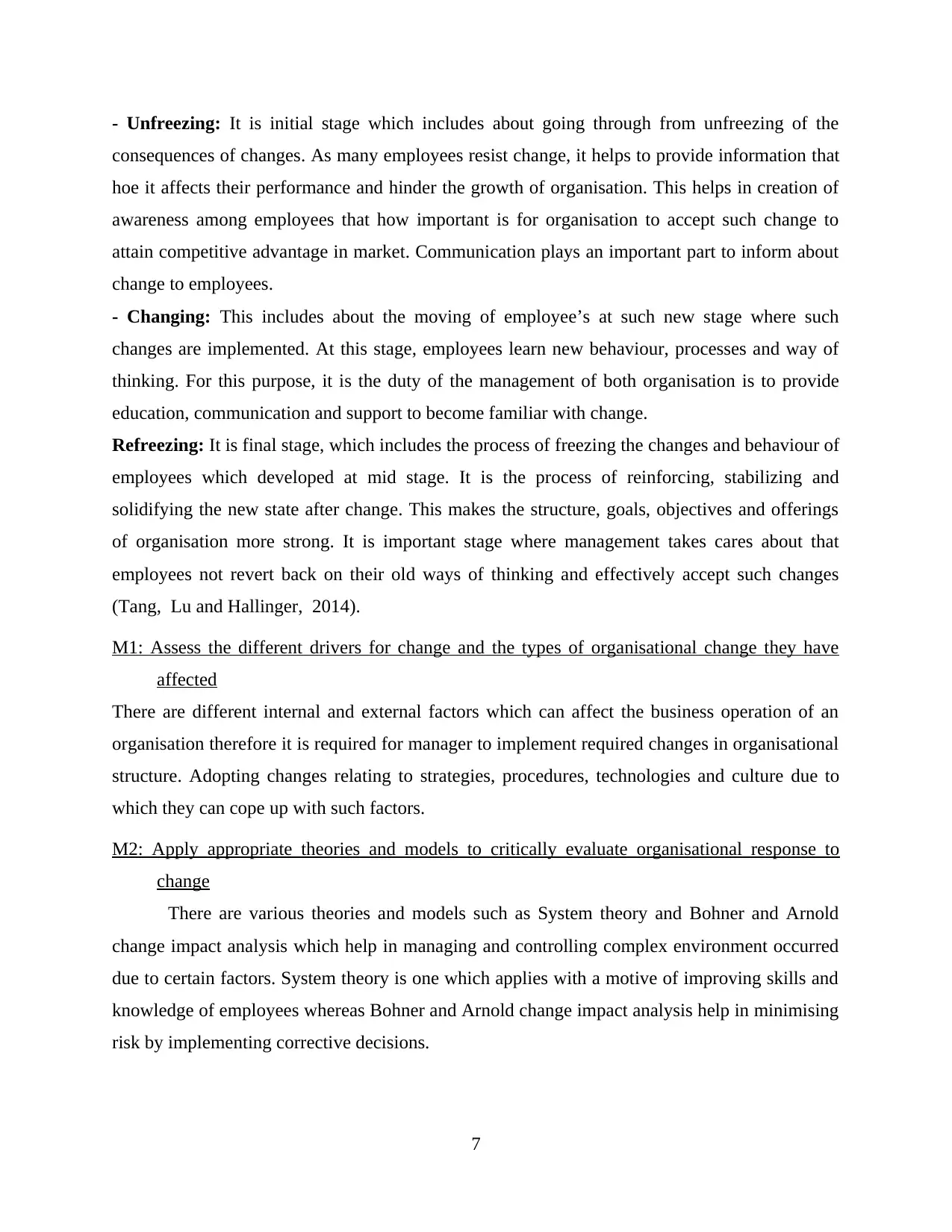
- Unfreezing: It is initial stage which includes about going through from unfreezing of the
consequences of changes. As many employees resist change, it helps to provide information that
hoe it affects their performance and hinder the growth of organisation. This helps in creation of
awareness among employees that how important is for organisation to accept such change to
attain competitive advantage in market. Communication plays an important part to inform about
change to employees.
- Changing: This includes about the moving of employee’s at such new stage where such
changes are implemented. At this stage, employees learn new behaviour, processes and way of
thinking. For this purpose, it is the duty of the management of both organisation is to provide
education, communication and support to become familiar with change.
Refreezing: It is final stage, which includes the process of freezing the changes and behaviour of
employees which developed at mid stage. It is the process of reinforcing, stabilizing and
solidifying the new state after change. This makes the structure, goals, objectives and offerings
of organisation more strong. It is important stage where management takes cares about that
employees not revert back on their old ways of thinking and effectively accept such changes
(Tang, Lu and Hallinger, 2014).
M1: Assess the different drivers for change and the types of organisational change they have
affected
There are different internal and external factors which can affect the business operation of an
organisation therefore it is required for manager to implement required changes in organisational
structure. Adopting changes relating to strategies, procedures, technologies and culture due to
which they can cope up with such factors.
M2: Apply appropriate theories and models to critically evaluate organisational response to
change
There are various theories and models such as System theory and Bohner and Arnold
change impact analysis which help in managing and controlling complex environment occurred
due to certain factors. System theory is one which applies with a motive of improving skills and
knowledge of employees whereas Bohner and Arnold change impact analysis help in minimising
risk by implementing corrective decisions.
7
consequences of changes. As many employees resist change, it helps to provide information that
hoe it affects their performance and hinder the growth of organisation. This helps in creation of
awareness among employees that how important is for organisation to accept such change to
attain competitive advantage in market. Communication plays an important part to inform about
change to employees.
- Changing: This includes about the moving of employee’s at such new stage where such
changes are implemented. At this stage, employees learn new behaviour, processes and way of
thinking. For this purpose, it is the duty of the management of both organisation is to provide
education, communication and support to become familiar with change.
Refreezing: It is final stage, which includes the process of freezing the changes and behaviour of
employees which developed at mid stage. It is the process of reinforcing, stabilizing and
solidifying the new state after change. This makes the structure, goals, objectives and offerings
of organisation more strong. It is important stage where management takes cares about that
employees not revert back on their old ways of thinking and effectively accept such changes
(Tang, Lu and Hallinger, 2014).
M1: Assess the different drivers for change and the types of organisational change they have
affected
There are different internal and external factors which can affect the business operation of an
organisation therefore it is required for manager to implement required changes in organisational
structure. Adopting changes relating to strategies, procedures, technologies and culture due to
which they can cope up with such factors.
M2: Apply appropriate theories and models to critically evaluate organisational response to
change
There are various theories and models such as System theory and Bohner and Arnold
change impact analysis which help in managing and controlling complex environment occurred
due to certain factors. System theory is one which applies with a motive of improving skills and
knowledge of employees whereas Bohner and Arnold change impact analysis help in minimising
risk by implementing corrective decisions.
7
Paraphrase This Document
Need a fresh take? Get an instant paraphrase of this document with our AI Paraphraser

TASK 2
P4 Different barriers for change and their influence on leadership decision-making
There are large number of barriers are present internally and externally. Such barriers
effects the capacity of organisation regarding acceptance of such changes. To understand more
about such concept, management of both M&S and Tesco decided to conduct Force Field
Analysis which is define below:
Force field analysis: This analysis shows the equilibrium between the such forces which
are in favour and against of changes in an organisation. It includes five stages which helps to
gather all information which plays and important part in implementation of change in an
organisation.
Step 1: Plan for change
It includes description of goals and visions for which organisation accept such changes in
their business operations. The main aim of M&S and Tesco behind acceptance of changes is to
attain competitive advantage, large market share, creation of innovation, gain loyalty of
customers etc.
Step 2: Identification of forces for change
It provides about such forces which are main reason for change in organisation. It can be
divided into two parts internal and external. Common forces faced by M&S and Tesco are define
below:
Internal drivers
Outdated machinery
low team morale
need improved productivity
External drivers
uncertain business environment
Customer's demands
Step 3: Identification of forces against changes
It includes factors which resist change.
Internal resistors
Fear of unknown
organisational structure
8
P4 Different barriers for change and their influence on leadership decision-making
There are large number of barriers are present internally and externally. Such barriers
effects the capacity of organisation regarding acceptance of such changes. To understand more
about such concept, management of both M&S and Tesco decided to conduct Force Field
Analysis which is define below:
Force field analysis: This analysis shows the equilibrium between the such forces which
are in favour and against of changes in an organisation. It includes five stages which helps to
gather all information which plays and important part in implementation of change in an
organisation.
Step 1: Plan for change
It includes description of goals and visions for which organisation accept such changes in
their business operations. The main aim of M&S and Tesco behind acceptance of changes is to
attain competitive advantage, large market share, creation of innovation, gain loyalty of
customers etc.
Step 2: Identification of forces for change
It provides about such forces which are main reason for change in organisation. It can be
divided into two parts internal and external. Common forces faced by M&S and Tesco are define
below:
Internal drivers
Outdated machinery
low team morale
need improved productivity
External drivers
uncertain business environment
Customer's demands
Step 3: Identification of forces against changes
It includes factors which resist change.
Internal resistors
Fear of unknown
organisational structure
8
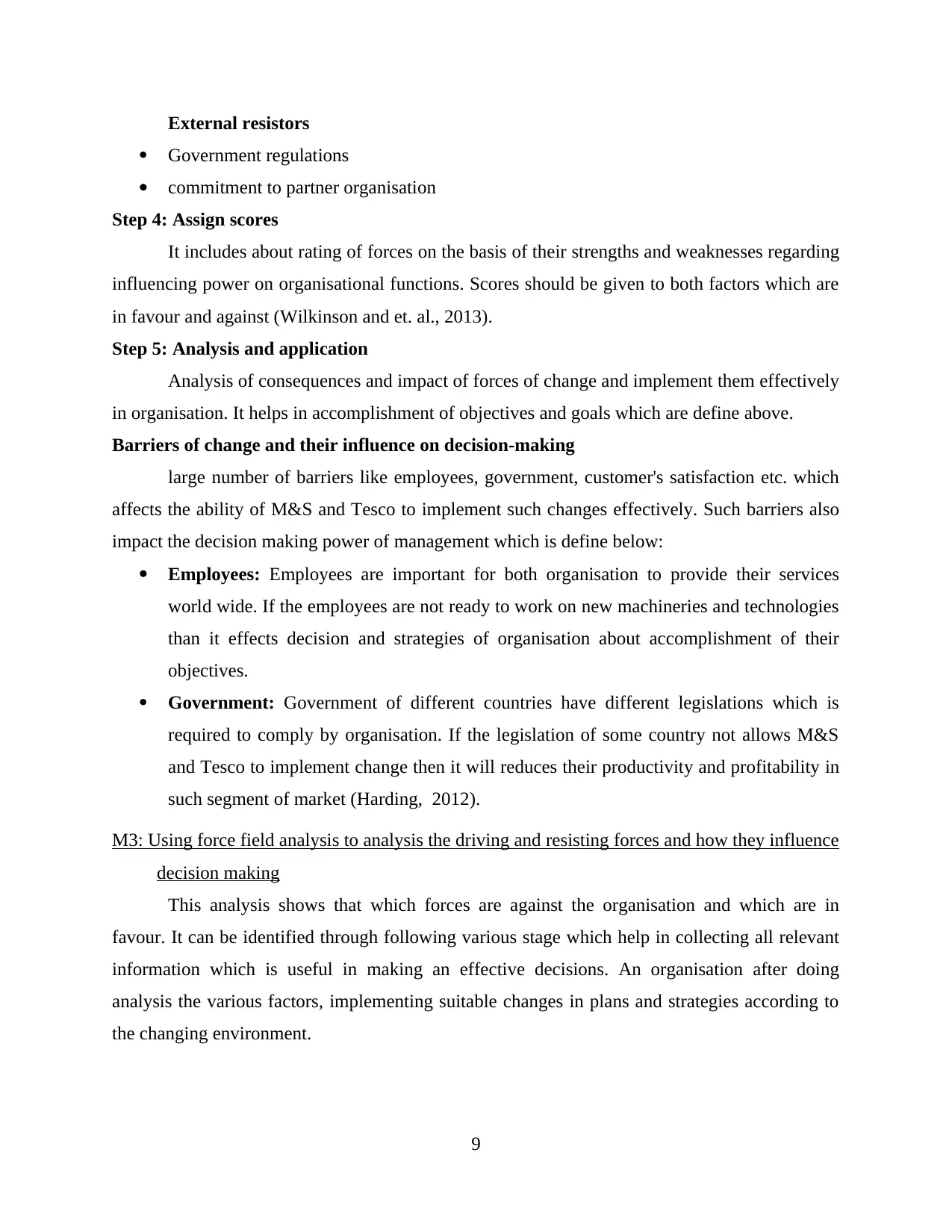
External resistors
Government regulations
commitment to partner organisation
Step 4: Assign scores
It includes about rating of forces on the basis of their strengths and weaknesses regarding
influencing power on organisational functions. Scores should be given to both factors which are
in favour and against (Wilkinson and et. al., 2013).
Step 5: Analysis and application
Analysis of consequences and impact of forces of change and implement them effectively
in organisation. It helps in accomplishment of objectives and goals which are define above.
Barriers of change and their influence on decision-making
large number of barriers like employees, government, customer's satisfaction etc. which
affects the ability of M&S and Tesco to implement such changes effectively. Such barriers also
impact the decision making power of management which is define below:
Employees: Employees are important for both organisation to provide their services
world wide. If the employees are not ready to work on new machineries and technologies
than it effects decision and strategies of organisation about accomplishment of their
objectives.
Government: Government of different countries have different legislations which is
required to comply by organisation. If the legislation of some country not allows M&S
and Tesco to implement change then it will reduces their productivity and profitability in
such segment of market (Harding, 2012).
M3: Using force field analysis to analysis the driving and resisting forces and how they influence
decision making
This analysis shows that which forces are against the organisation and which are in
favour. It can be identified through following various stage which help in collecting all relevant
information which is useful in making an effective decisions. An organisation after doing
analysis the various factors, implementing suitable changes in plans and strategies according to
the changing environment.
9
Government regulations
commitment to partner organisation
Step 4: Assign scores
It includes about rating of forces on the basis of their strengths and weaknesses regarding
influencing power on organisational functions. Scores should be given to both factors which are
in favour and against (Wilkinson and et. al., 2013).
Step 5: Analysis and application
Analysis of consequences and impact of forces of change and implement them effectively
in organisation. It helps in accomplishment of objectives and goals which are define above.
Barriers of change and their influence on decision-making
large number of barriers like employees, government, customer's satisfaction etc. which
affects the ability of M&S and Tesco to implement such changes effectively. Such barriers also
impact the decision making power of management which is define below:
Employees: Employees are important for both organisation to provide their services
world wide. If the employees are not ready to work on new machineries and technologies
than it effects decision and strategies of organisation about accomplishment of their
objectives.
Government: Government of different countries have different legislations which is
required to comply by organisation. If the legislation of some country not allows M&S
and Tesco to implement change then it will reduces their productivity and profitability in
such segment of market (Harding, 2012).
M3: Using force field analysis to analysis the driving and resisting forces and how they influence
decision making
This analysis shows that which forces are against the organisation and which are in
favour. It can be identified through following various stage which help in collecting all relevant
information which is useful in making an effective decisions. An organisation after doing
analysis the various factors, implementing suitable changes in plans and strategies according to
the changing environment.
9
⊘ This is a preview!⊘
Do you want full access?
Subscribe today to unlock all pages.

Trusted by 1+ million students worldwide
1 out of 16
Related Documents
Your All-in-One AI-Powered Toolkit for Academic Success.
+13062052269
info@desklib.com
Available 24*7 on WhatsApp / Email
![[object Object]](/_next/static/media/star-bottom.7253800d.svg)
Unlock your academic potential
Copyright © 2020–2025 A2Z Services. All Rights Reserved. Developed and managed by ZUCOL.





